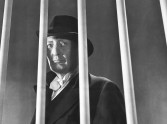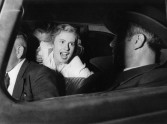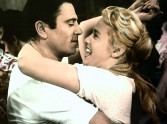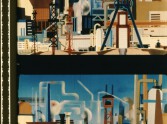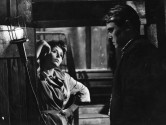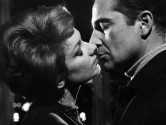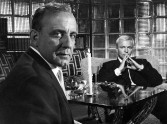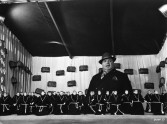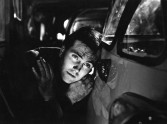
Mapping Gray Zones.
The Inexact Beauty of Early West German Cinema, 1949 – 1963
In a 1960 essay called Hierzulande, Heinrich Böll describes the difficulties of explaining the Federal Republic of Germany to a friend from abroad. He uses a rather intriguing adjective in this piece to refer to the young nation: ungenau,or inexact. He means that the Federal Republic was characterized by contradictions and paradox, or, to put it more casually: things refuse to add up—at least in the way most people would have liked. Which goes like this: after May 8th 1945 and some serious re-education, Germans understood the error of their ways and changed from the master race to a humble bunch of penitents—the Zero Hour myth. Germany hadn’t changed overnight; yet changed it had, little by little and sometimes even in great leaps (of faith), not too radically but gradually, in a way maybe more human yet decidedly less easy to narrate, one of compromise, all shades of grey with little black and almost no white. So while the nation’s government, led by chancellor Konrad Adenauer, was indeed a frighteningly conservative, and at times blatantly reactionary one, good parts of the citizenry did refuse to fall in line with its policies. People were fighting against the FRG’s armament, against it becoming a NATO member, for better labour laws, for women’s rights. Few of these challenges, or shows of dissent and defiance, ended in immediate all-out victory, but they did change the nation in the long run.
The FRG fifties are not a lost decade, as popular liberal mythology likes to have it—a silent one, maybe, similar to the States, but not a lost one. And, yes, the films of the period do tell this story. With all their unpredictable twists and turns of stories and fates, double and triple endings, clashes and/or layers of styles and genres, 1950s West German cinema bears witness to this surprising and often creative quest for a modern democratic state out of the rubble of a modern fascist dictatorship. Ottomar Domnick’s Neue Kunst – Neues Sehen, Bernhard Wicki’s Das Wunder des Malachias, Wolf Hart’s Werftarbeiter, Gerd Oswald’s Am Tag, als der Regen kam, Wolfgang Staudte’s Rose Bernd, Harald Braun’s Der gläserne Turm and Helmut Käutner’s Die Rote / La rossa, among others, provide cinema commentary on these developments.
It doesn’t mean that people cared to listen. For things cinema and Federal Republic, the Zero Hour myth worked very well, if mainly retroactively. Because the decisive moment came almost two decades later, in 1962 on February 28th at the 8th West German Days of the Short Film Festival in Oberhausen, where twenty-six filmmakers proclaimed: The old cinema is dead. We believe in the new one. That several of the directors who made this claim had learned their craft in the industry they now derided, and that some of their greatest works are best described as avant-garde ads for Adenauer-era accelerated industrial development (eg. Ferdinand Khittl’s Das magische Band, Haro Senft’s Kahl), is quite another matter—another one of those contradictions ...
One of the Oberhausen Manifesto’s cultural legacies is a vast blank space. By now, FRG 50s cinema remains essentially unknown abroad, and at home it’s considered a special case. Vanished from the screens big and small where it was still a formidable presence until the coming of the Berlin Republic post-‘89, badly preserved by the nation’s various archives, buried under heaps of clichés and truisms about the period long debunked by academia in fields like history or sociology, it has become more difficult than ever to discuss this era in German film history.
The one thing acceptable to like from this time and place are the works of Wolfgang Staudte (even if the ones venerated were mainly East German state (DEFA) productions) and Helmut Käutner, the era’s two-star auteur. But, please, don’t take the former’s pleasure in his craftsmanship and genre-savviness too seriously, and neither the latter’s political bite, for that would confuse received wisdom on their respective arts. Having anything good to say about other major directors of the period like Harald Braun, Rolf Thiele, Rolf Hansen, Kurt Hoffmann, Robert Adolf Stemmle or Frank Wisbar counts for wilful eccentricity. The same holds true for a serious interest in the era’s key genres: comedies (musical or not), Heimatfilme, crime movies, melodramas, war films (and woe betide if you dare to make some slightly more serious claims for the abilities of those who made crafting entertainments their niche; it might be okay to praise Phil Karlson or Joseph Kane, but don’t dare to suggest that their West German colleagues like Hans Deppe, Paul May, Harald Reinl or Paul Martin should deserve the same cinéphile care and attention). Ditto a love for this cinema’s stars, some of whom had strong international careers. While we’re at it, here’s one of those clichés regurgitated for decades: only abroad could all those talents show how good they really were. Well, the only thing they showed was the versatility of their craft: that they were able to play in styles popular back home as well as in fashions preferred in other cultural spheres; mind that Ruth Leuwerik, for instance, one of the period’s biggest stars, was vilified when she gave her performance in Die Rote an air of haughty Antonionian despair, and Sonja Ziemann, the era’s other major female box office draw, was looked at with barely suppressed disdain when she tinged her performance in Aleksander Ford’s Der achte Wochentag / Ósmy dzień tygodnia with some Thaw-sulkiness. It was okay to be different… elsewhere. But where is home anyway?
Which also means: the Young German Cinema hotshots’ vitriolic denunciations of West German 50s cinema merely reinforced what the ancien establishment (liberal as well as conservative) had proclaimed all the time. Audiences might have adored the Bonn Republic film production, grosso modo (as long as it catered to their tastes), but critics didn’t. Reading through the writings of many major reviewers active in these years, one gets the impression that the industry and its artists could barely do right; the more or less unreserved praise for films like Victor Vicas’ Weg ohne Umkehr or Peter Pewas’ Viele kamen vorbei by key critics of the age like Gunter Groll were massive exceptions.
Yet this reading brings forth something else: the press back then showed a huge interest in short films and their potential. Long articles were devoted to animation gems like Rolf Engler’s Traum in Tusche or Florenz von Nordhoff’s Die Purpurlinie; proper attention was paid to experiments like Volkswagen’s stereoscopic productions exhibited mainly at trade fairs (e.g., Curt A. Engel’s Ein Wagen und sein Werk), or Herbert Viktor’s self-consciously modern promotional film Schichten unter der Dunstglocke, financed by the city of Oberhausen; while one of the biggest animation masters of the day, Hans Fischerkösen, was treated with a generosity even Staudte and Käutner could envy. And there was good reason for that… All these experiments might, just might, lead to something different in the industry’s middle-ground, the core of its production: the fiction feature. Change seemed to be everywhere, or at least desirable.
This program is a digest/variation of a much vaster retrospective on the subject presented at the Locarno Film Festival 2016 under the title Beloved and Rejected. Both were conceived as invitations to further exploration, as sketches of a map in dire need of textures and colors. In contrast to any earlier explorations of the period (in the late 1980s in the FRG as well as the early 2000s in the USA), attention was also paid to all aspects of production beyond narrative feature films, to give a more proper idea of the various riches to be found here. – Olaf Möller, born, raised, still living in Cologne, writes about and programs films.
